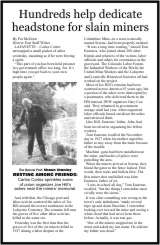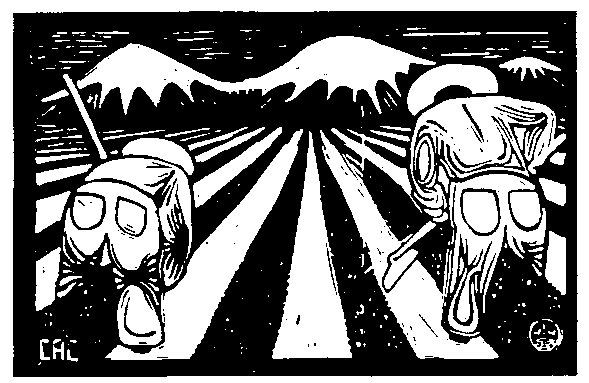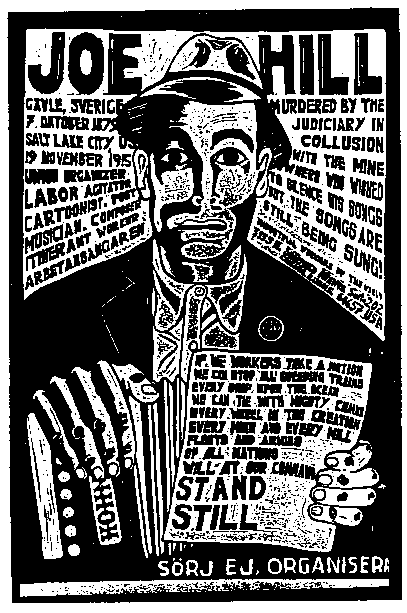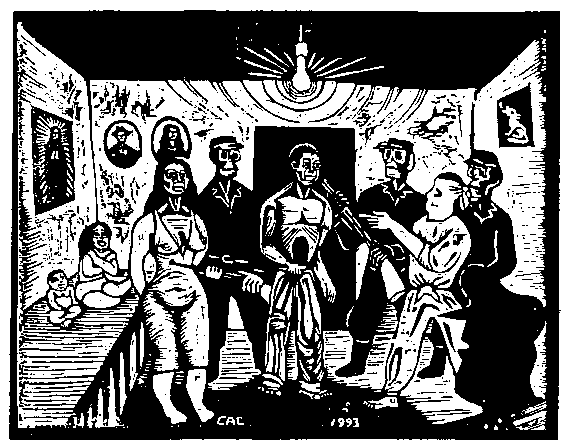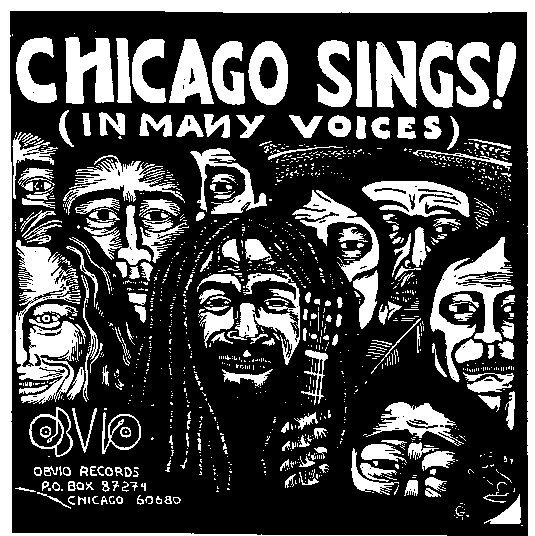| |
|
Here's another example of the Carlos Cortez philosophy
and style: REQUIEM
FOR A STREET
Other important Carlos Cortez works are here,
including one of the artist's favorites, a 1978 linocut of Mexican
anarchist Ricardo Flores-Magon.
Chicago
Says Farewell To Carlos Cortez, Indymedia Story
SEMCOSH
in Michigan on Carlos cortez
Manya
A. Brachear obit article from the Chicago Tribune
From the Industrial Worker—
Sun Sets On Red Cloud
and a Coyote Howls-- C. C. Red Cloud, Koyokuikatl (song of the Coyote in the Nahuatl
language of the Aztecs), and X321826, were just a few of the many
noms de plume that Carlos Cortez used in his many Left Side columns,
poems, cartoons, and drawings that we enjoyed in the Industrial
Worker since Carlos joined the I.W.W. in 1947. He joined shortly
after serving 18 months of a two-year sentence in Sandstone federal
prison in Minnesota for his refusal to take any part in the killing
of other working people during the second world gang fight for
power and wealth. He told me that he began using the symbol of
Koyokuikatl after his imprisonment in Sandstone, where he could
hear the coyotes singing at night through his cell window. To him,
and most western Indians, the coyote is a symbol of a wise trickster
and of freedom. The taunting howls at midnight reminded him that
he was more free in there than those who blindly followed the orders
of the state. He would be released shortly. It was many of the
guards that would serve a life sentence at Sandstone.
Carlos listened once more to the taunts of his cousins early
in the morning on January 18, 2005. This time he returned to
them. He was tired of the pain
in his old weak heart and he missed his beloved wife, Marianna, terribly. She
left her human form in 2001. He was devastated because she had promised to
go last so she could take care of him. Carlos had suffered serious heart problems
since 1981. After she departed, there was no one to discipline him when we
opened his Wild Turkey bottle for our evening ritual. "Carlos, one is
enough." "But, Marianna, Gary is here all the way from Colorado.
We must be polite." She would come in, wink at me, pour our glasses full
one last time, take the bottle, pinch his cheek and leave. "What can you
do with a Greek," he would say with a sparkle in his eye. Marianna, he
never let anything dominate him. He could always limit himself, but there was
no fun in that, no twinkle in his eyes if he must discipline himself.
Carlos did not fear returning to his mother earth. In one of his books of poetry, "de
Kansas a Califas," he wrote:
Tumbleweeds
When the Tumbleweed
Has finished his days of existence,
The roots that bind him down
To Earth Mother
Give way
And he can go wherever
The wind takes him.
How much better
Than a tombstone
And the Pearly Gates!
Carlos came to Colorado in 1989 to introduce the last of Joe Hill's ashes to
the five I.W.W. miners murdered in 1927 during a clash on the picket line at
the Columbine coal mine near Erie , Colorado, just a few miles north of my
home. We were dedicating a new tombstone over the graves of these miners and
Carlos had ridden the train out as the official representative of the I.W.W..
These were Wobblies buried here and we had promised them a headstone in 1927;
but the union was broke and the promise was lost in the sadness of the government
attacks on the I.W.W. Carlos came to keep that promise 62 years later. We Never
Forget.
Carlos stayed with us while in Denver for this week-long event. Carol and I
walked him out to our local prairie dog colony one afternoon. He loved them
and couldn't stay away. I caught him chanting to his cousins to leave these
cute pups alone. Carlos felt related to all living things, but especially these
guys and his coyotes. If I wanted to hear his voice, which was often, I would
send him a picture of a little fat prairie dog.
I have never met a more gentle and honest man in my life. What you saw is what
you got. I first met Carlos at the first I.W.W. convention I had ever attended
in 1970, and like many before and after me, he became a close friend. If he
could be labeled, I think only "friend" sticks to him long. Any
time I visited his home near Lincoln Park in Chicago, there were friends dropping
in from all over the country and each was made to feel at home. As his caretaker
his last few months, Steve, told me on the phone a few days after Carlos left, "They
did not come because they liked him. They came because they loved him." I
know I did.
His home had been a mom-and-pop grocery store at one time. The front room,
which was the store, is now a huge art gallery, library containing his many
books, a dining table, and welcome room for the many guests and anarchist conversations
that they brought with them. Those walls hold many warm memories. In the basement
is Carlos' old press. El Gato Negro was producing papers here many years ago
and lately his many wood block art pieces and linocuts which we are all so
familiar with. In the back, where the owners of the grocery store used to live,
are miles of bed rooms. There always seem to be enough for any Wob passing
through.
Carlos did not want this home. He did not like the idea of owning anything.
But Marianna had other plans. When Carlos brought her to Chicago as a new bride,
she made up her mind. She worked hard, sometimes three jobs doing backbreaking
work. She saved until she chose this home to buy from the money she had rat-holed.
Carlos loved and respected her so much that he gave in and brought his brushes
and printing press--- and all his companeros. Carlos identified with his Indian
side because he decided that the communal spirit of the Indian and their care-taking
attitude towards Mother Earth was closest to his true nature. But he made his
nest here on the Northside, nevertheless.
Carlos was born of very loving, tolerant parents. His father was a Mestizo
from Mazatlan, Mexico, who emigrated to the U. S. with his parents as a child.
Born in Mexico in 1880, Alfred E. Cortez grew up in California. He joined the
I.W.W. free speech fight in San Diego in 1912 and joined the I..W.W. in 1916.
He was a construction worker who spoke five languages. Carlos' mother, Augusta,
was born to immigrant German parents in Racine Wisconsin. She belonged to the
Socialist Party of America and was a strong supporter of Eugene Debs. Alfred
and Augusta were married in 1921 and Carlos was born in 1923, in Milwaukee
Wisconsin.
I would say we could call Carlos a red baby. Carlos loved his father and his
finely chiseled, dark Indian features; but his artistic bent, as well as his
pacifism, were inherited from Augusta. Carlos joined the Young People's Socialist
League as a young man, but after his prison tour, found party politics entirely
too confining and he joined the I.W.W. in 1947. He identified himself as an
anarchosyndicalist from that point until answering the coyotes call at 81 years
of age. He wrote in his Left Side column often of his distrust of the political
system. "If voting could remove the power structure, voting would be
declared illegal." Think about that. He voiced his opinion and let it
go at that. He rarely chastised anyone because they believed differently. He
took anarchism
seriously and allowed you your space to be free. He had grown up in a home
where the father believed strongly in anarchosyndicalism, although Alfred always
voted the Socialist ticket in case it would help someone who was homeless even
a little, while his mother was an avowed member of the Socialist Party of America.
Carlos said they never split hairs and always defended one another. He learned
tolerance from them. Carlos mentioned very often to me as we sat out on his
sidewalk with our traditional shot of Wild Turkey and a hand-rolled cigarette
in the heat of Chicago's summer evenings, waving at the neighbors who loved
him also, especially the youngsters, that until the I.W.W. could imitate that
kind of respect and tolerance for one another, it would have a difficult time
holding conventions of any merit.
We talked of many things on his front steps under the influence of the flopping
turkey and sometimes a moon. We talked of why we loved the I.W.W. We both felt
that violent revolution was bound to fail, even if it could be won; that political
results could provide, at best, short temporary relief for the underbelly,
but nothing permanent; and that there was the danger of false hopes for real
change in those who voted. We both believed in the ability of workers to control
their own lives, and, if tolerance is learned, the ability of small independent
democratic units to encourage just that. Who but the I.W.W. fosters this philosophy?
Many join the One Big Union for romantic reasons but we have remained Wobblies
this long because we truly believe that this union offers real potential for
workers to free themselves of the indignity and repression of capitalism (state
or laissez faire) by simply withdrawing our labor en masse and believing in
ourselves. Evidently, the powerful agree with us or the Palmer Raids and Judy
Bari's car being bombed would not have been necessary.
It is believing in ourselves and learning tolerance for the opinions of others
that are hard. Withdrawing labor is a pleasant task. Carlos would leave us
that challenge, I think. After Marianna left, we were sitting out front on
folding chairs on my last visit in August of 2004. The moon appeared through
the trees. He looked up and howled quietly. I knew he didn't want to wait long.
Few artists are honored while they live, but Carlos has been bombarded with
praise, especially recently. He has taken the cause of liberation and the I.W.W.
to many neighborhoods in Chicago, to many states of the union, and to many
countries of the world. In October, 1999 he was honored with an exhibition
of his art in Madrid, Spain by the Foundation of Libertarian Studies. They
produced a very nice pamphlet of Carlo's art with his self portrait from 1985
on the cover.
In 2001, he was honored in Chicago by the Mexican Fine Arts Center with a large
three- month long exhibition of his art. Then all of his art was permanently
hung in the Mexican Fine Artes Museum in Chicago with the promise that if his
art becomes too expensive for working people, they must produce more to reduce
the price. Those who profit from his passing beware visits from owls, coyotes,
or ravens.
In August of 2004, at the opening of The House of the Culture of Meztizo Art
at 1440 West 18th Street, Chicago, Carlos' work was featured and the show
was called, "El Coyote Vive" (The Coyote Lives). I was at his home
when they were planning this exhibition. Judging from the light in his eyes,
this one meant the most
to him. He was getting very weak and he knew it might be his last. It was a
new local gallery, the artists involved were close friends, and it was a more
working class gallery. They were so good to him. They tried many ways, with
Steve's welcome help, to get him to poetry readings for children; for example.
His art was compared to some of the greats, like Diego Rivera. I am no art
critic, but I liked his art and poetry very much. First, I was amazed to watch
him carve his painting backwards into wood. This was an old art form for posters--
working class because it was cheap. Carlos delighted in producing his art from
scrap others had thrown away. He tried to protect his mother earth right to
the end. Something about the simple black and white images holds the eye, but
even more, the images were always about humanity. They needed no explanation
A father and mother bent over a flag-draped coffin. I have this one on my wall
now as I type this. It will be current until capitalism strangles itself. Farm
workers bent in the fields under a burning sun with a map of Texas on the sun.
Need any explanation? Or his empty jail cell at Sandstone prison. Children
looking up at a large poster of "their uncle" Sam who points his
finger saying,
"I Want You." In his book of poems,"Where Are The Voices?" referring
to the Hay Market Martyrs , he wrote;
Houn' Dog
Trotting along the sidewalk
with not a feline in sight
to give chase to
and not a girl doggie in sight
that he can pursue
but just as happy as
only a houn' dog can be,
he espies the recruiting poster
in front of the post office.
His tail stops wagging
long enough
as he cranes his head forward
to make the sniff test
and upon seeing that it
does not sniff too well,
with excellent body english
and a back paw salute,
he administers upon this artifact
of an alleged higher creation,
his most eloquent appraisal.
We, the working class of the world, have lost a great friend and mentor. That
long and mournful howl you heard was mine or it was Carlos' answer. Join me.
Let king george hear it!!
You may obtain Carlos'prints or his poetry from this paper, which helps support
the Industrial Worker, or from Carlos' good friend, Franklin Rosemont, at the
great Charles Kerr Publishing House, 1740 Greenleaf Avenue, Chicago Illinois,
60626. Franklin will send you a catalog of everything he carries. While you
are waiting, check out this web site created by our artist here in Denver at:
www.rebelgraphicsorg/carloscortez.html.
Hopefully, the I.W.W. can find a way to exhibit his art and poetry around the
U.S. as part of the 100th celebration. He served this union almost 60 of those
100 years. What cha' think, Wobs?
Gary Cox
|
|


